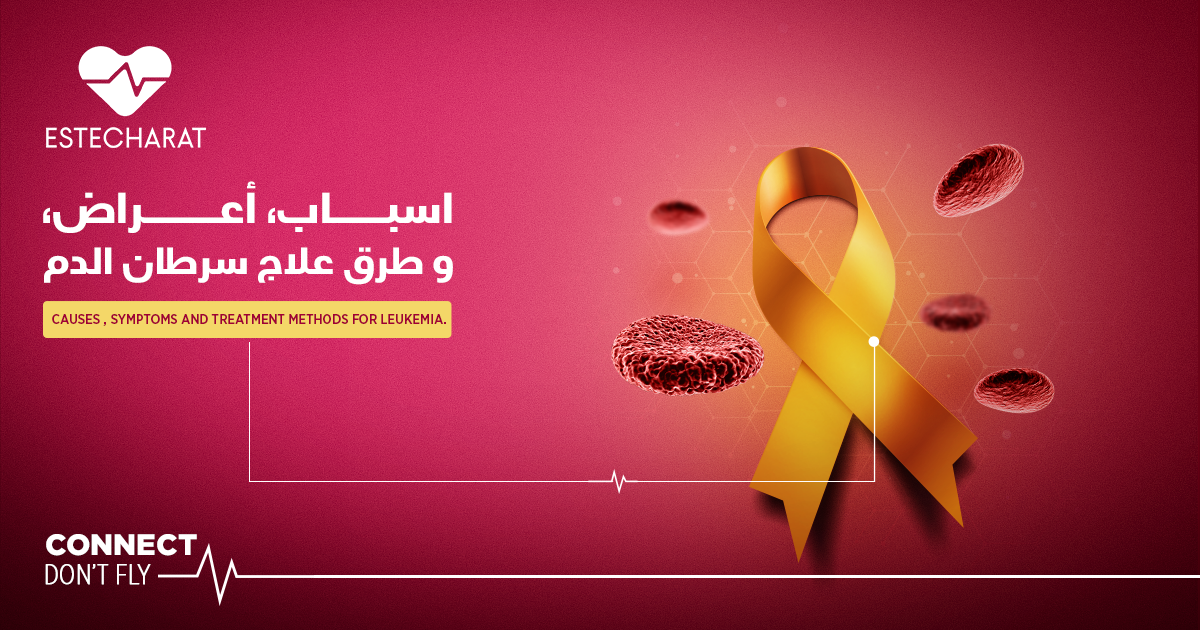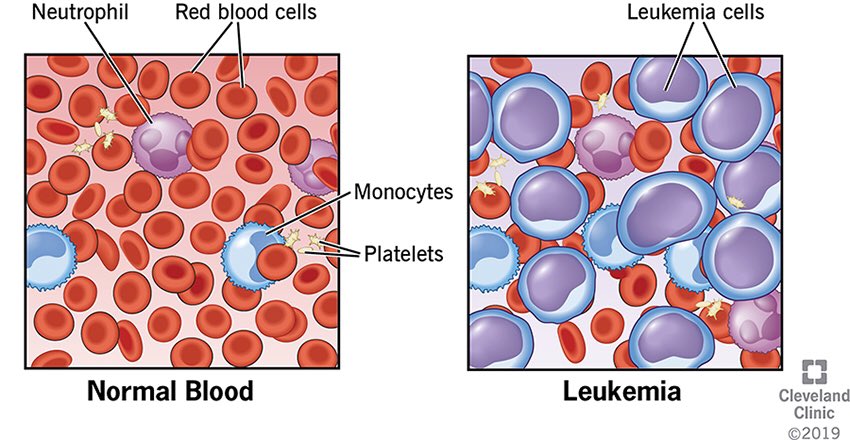
We are a leading digital healthcare platform that connects top Egyptian specialists & patients for medical second opinion consultations services

Leukemia starts when the DNA of a single cell in your bone marrow changes (mutates) and can’t develop and function normally. Leukemia cells often behave like abnormal white blood cells. Treatments for leukemia depend on the type of leukemia you have, your age and overall health, and if the leukemia has spread to other organs or tissues.
Leukemia is a cancer of the blood, characterized by the rapid growth of abnormal blood cells. This uncontrolled growth takes place in your bone marrow, where most of your body’s blood is made. Leukemia cells are usually immature (still developing) white blood cells.

The onset of leukemia can be acute (sudden onset) or chronic (slow onset). In acute leukemia, cancer cells multiply quickly. In chronic leukemia, the disease progresses slowly and early symptoms may be very mild.
There are four main types of leukemia:
Acute myeloid leukemia (AML) can occur in children and adults. According to the Surveillance, Epidemiology, and End Results Program of the National Cancer Institute (NCI)Trusted Source, about 20,000 new cases of AML are diagnosed each year in the United States. This is the most common form of leukemia. The 5-year survival rate for AML is 29.5 percent.
Acute lymphocytic leukemia (ALL) occurs mostlyTrusted Source in children. The NCITrusted Source estimates about 6,000 new cases of ALL are diagnosed annually. The 5-year survival rate for ALL is 69.9 percent.
Chronic myeloid leukemia (CML) affects mostly adults. About 9,000 new cases of CML are diagnosed annually, according to the NCITrusted Source. The 5-year survival rate for CML is 70.6 percent.
Chronic lymphocytic leukemia (CLL) is most likely to affect people over age 55. It’s very rarely seen in children. According to the NCITrusted Source, about 21,000 new cases of CLL are diagnosed annually. The 5-year survival rate for CLL is 87.2 percent.
Hairy cell leukemia is a very rare subtype of CLL. Its name comes from the appearance of the cancerous lymphocytes under a microscope.
The symptoms and signs of leukemia depend upon the type of leukemia. As stated earlier, slow-growing or chronic leukemia may not cause any symptoms at the outset, while aggressive or rapidly growing leukemia may lead to severe symptoms. The symptoms of leukemia arise from a loss of function of the normal blood cells or from the accumulation of the abnormal cells in the body.
Signs and symptoms of leukemia typically include the following:
*Fevers
*Night sweats
*Swollen lymph nodes that are usually painless
*Feelings of fatigue, tiredness
*Easy bleeding or bruising, causing bluish or purplish patches on the skin or tiny red spots on the skin, or recurring nosebleeds
*Frequent infections
*Bone or joint pain
*Weight loss that is unintentional and otherwise unexplained, or loss of appetite
*Enlargement of the spleen or liver, which can lead to abdominal pain or swelling
*Red spots on the skin (petechiae)
If leukemia cells have infiltrated the brain, symptoms such as headaches, seizures, confusion, loss of muscle control, and vomiting can occur.
Leukemia starts when the DNA of a single cell in your bone marrow changes (mutates). DNA is the “instruction code” that tells a cell when to grow, how to develop and when to die. Because of the mutation, or coding error, leukemia cells keep multiplying. All cells arising from the original mutated cell also have the mutated DNA.
Scientists don’t know what causes these developing cells to mutate. They’ve been able to identify some common mutations that people diagnosed with different types of leukemia share.
Most cancers are staged based on the size and spread of tumors. However, because leukemia occurs in the developing blood cells in the bone marrow, leukemia staging is a little bit different. The stages of leukemia are often characterized by blood cell counts and the accumulation of leukemia cells in other organs, like the liver or spleen, with each subtype staged using a system designed specifically for leukemia.
Making an educated treatment decision begins with the stage, or progression, of the disease. The stage of leukemia is one of the most important factors in evaluating treatment options. Factors affecting leukemia staging and prognosis include:
*White blood cell or platelet count
*Age
*History of prior blood disorders
*Chromosome mutations or abnormalities
*Bone damage
*Enlarged liver or spleen
One way cancer patients can estimate life expectancy is to review the five-year relative survival rate for that cancer type. This indicates how many people with the same type of cancer are alive five years or more after a diagnosis, compared to people who don’t have that cancer type.
The overall five-year relative survival rate for leukemia is 66.7 percent, according to the National Cancer Institute SEER (Surveillance, Epidemiology and End Results) Program.
Five-year relative survival rates differ depending on the type of leukemia. Below are the overall five-year relative survival rates.
*ALL survival rates: According to the SEER Program, the overall five-year relative survival rate is 71.3 percent. Learn more about ALL survival rates.
*AML survival rates: According to the SEER Program, the overall five-year relative survival rate is 31.7 percent. Learn more about AML survival rates.
*CLL survival rates: According to the SEER Program, the overall five-year relative survival rate is 88 percent. Learn more about CLL survival rates.
*CML survival rates: According to the SEER Program, the overall five-year relative survival rate is 70.6 percent. Learn more about CML survival rates.
Keep in mind that the survival rate for leukemia depends on a variety of factors, including the patient’s age, overall health and the extent of the disease, so always talk to the care team about the patient’s individual prognosis.
We are a leading digital healthcare platform that connects top Egyptian specialists & patients for medical second opinion consultations services
Email Us
| Cookie | Duration | Description |
|---|---|---|
| cookielawinfo-checkbox-advertisement | 1 year | Set by the GDPR Cookie Consent plugin, this cookie is used to record the user consent for the cookies in the "Advertisement" category . |
| cookielawinfo-checkbox-analytics | 11 months | This cookie is set by GDPR Cookie Consent plugin. The cookie is used to store the user consent for the cookies in the category "Analytics". |
| cookielawinfo-checkbox-functional | 11 months | The cookie is set by GDPR cookie consent to record the user consent for the cookies in the category "Functional". |
| cookielawinfo-checkbox-necessary | 11 months | This cookie is set by GDPR Cookie Consent plugin. The cookies is used to store the user consent for the cookies in the category "Necessary". |
| cookielawinfo-checkbox-others | 11 months | This cookie is set by GDPR Cookie Consent plugin. The cookie is used to store the user consent for the cookies in the category "Other. |
| cookielawinfo-checkbox-performance | 11 months | This cookie is set by GDPR Cookie Consent plugin. The cookie is used to store the user consent for the cookies in the category "Performance". |
| viewed_cookie_policy | 11 months | The cookie is set by the GDPR Cookie Consent plugin and is used to store whether or not user has consented to the use of cookies. It does not store any personal data. |
| Cookie | Duration | Description |
|---|---|---|
| _ga | 2 years | The _ga cookie, installed by Google Analytics, calculates visitor, session and campaign data and also keeps track of site usage for the site's analytics report. The cookie stores information anonymously and assigns a randomly generated number to recognize unique visitors. |
| _ga_530K1V7VWR | 2 years | This cookie is installed by Google Analytics. |
| Cookie | Duration | Description |
|---|---|---|
| nitroCachedPage | session | No description |